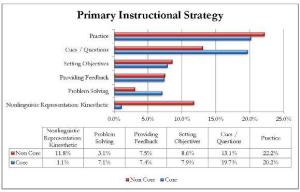Imagine you’re conducting classroom walkthroughs and, as you walk by a music classroom, you hear the sound of student voices singing beautifully. “They are all busy practicing together again,” you think as you continue on toward a U.S. history classroom down the hall.
Wait a minute—did you just skip the music teacher’s classroom?
The music teacher needs to feel valued as a teacher as much as the history teacher does. Stopping in her classroom, and other “non-core” classrooms, to observe is just as important as seeing what happens in math, science, social studies, and language arts.
To get a clear picture of the instruction happening in all of your classrooms, McREL recommends that every teacher, core and non-core, be observed twice a week. While this may seem daunting, walkthroughs can be conducted by principals, coaches, other administrators, or fellow teachers as long as they have been through sufficient training on the “look-fors.” The benefit of conducting walkthroughs and providing formative feedback to teachers is two-fold: It improves communication and helps with goal setting, and the data gathered during walkthroughs can be used to make informed decisions about professional development and coaching opportunities.
In just a couple of months of walkthroughs, you will collect enough data to identify what instruction looks like in your school (as well as in specific content areas), what teachers are doing well, and areas where they need support. As you conduct more walkthroughs, you’ll also get valuable information about how often and how well particular instructional strategies are being used.
As an example, look at the data in this graph, taken from a sample of more than 150,000 walkthroughs recently conducted by Power Walkthrough® users around the world. Notice that there are some differences in strategies being used in core versus non-core classrooms. How does this compare to what you think you’d find in your own school?
Lisa Maxfield is a managing consultant at McREL International, where she provides information and support for McREL’s Power Walkthrough informal observation software.



This is timely. In an atmosphere of high stakes testing it is very easy for ‘non core’ teachers to feel that their discipline is a kind of optional extra. In fact music and art education are just as ‘core’ as mathematics, English, science and social studies. The non tested subjects are core to a rounded education.
I find the graph most interesting. At our school it is the non core teachers who have the fewest behavior issues. You would think the teacher who is more time vested would have an easier time with behaviors. Perhaps it is the heavy use of nonlinguistic kinesthetic representation by non core teachers that is leading to fewer behavior issues. I also note that those teachers do cover their curriculum. I often not only walk through our music teacher’s room, but often stay to watch her magic. She uses Education Through Music techniques which are research based and useful for core teachers also.
Thank you for sharing the value of making frequent walk-throughs in ALL classrooms. As the administrator in a non-traditional Montessori school, I often find myself willing to skip over toddler or after-school programs, putting more emphasis on our elementary, especially when time is in short supply. It is good to be reminded of the value each aspect of the school community brings to the whole.
It is nice to see non -core subjects being looked at in regards to walk throughs as each subjects is valuable and has something to offer.
It is really interesting that the non-linguistic representation is almost non-existent in the core subjects that were observed. These subjects are often felt to be the most enjoyable by many students and, as well as content, it may well be accessibility for students that contributes to this.
I find that it is invaluable for all classrooms to be a part of a walk through or observational program. How else can we achieve whole school improvement. Do you recomend different criteria for different content areas?
It is great to see that there is an emphasis for walkthroughs to be conducted in both core and non core subjects. It allows for a whole school approach and allows for greater understanding and knowledge (including opportunities for everyone to learn).
Coaching in schools is becoming a big thing which I agree is an important aspect of teaching. I come from a school where coaching is highly valued and is put into practice regularly. However, I believe that observation is just as important and should also be put into practice on a more regular basis as we have alot to learn from others including allowing more time for practice as non-core subjects are doing.
Hi Shona. No, we generally do not recommend different criteria, in terms of instructional strategies, for different content areas.
For some quick tips to use in your classroom, visit McREL on YouTube (http://www.youtube.com/playlist?list=PLCCDFB32544F1A3F1) to view short CITW videos by the authors of Classroom Instruction that Works, 2nd Edition.